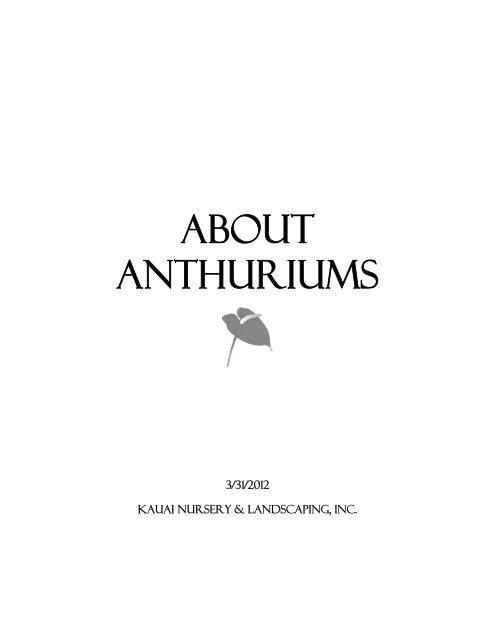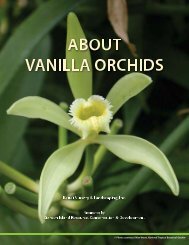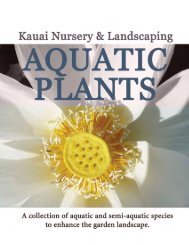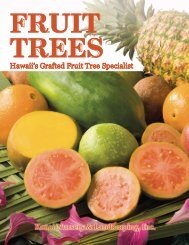Horticulture Digest - Kauai Nursery & Landscaping, Inc.
Horticulture Digest - Kauai Nursery & Landscaping, Inc.
Horticulture Digest - Kauai Nursery & Landscaping, Inc.
You also want an ePaper? Increase the reach of your titles
YUMPU automatically turns print PDFs into web optimized ePapers that Google loves.
ABOUT<br />
ANTHURIUMS<br />
3/31/2012<br />
<strong>Kauai</strong> <strong>Nursery</strong> & <strong>Landscaping</strong>, <strong>Inc</strong>.
BACKGROUND<br />
Native to Central and South America, the Anthurium includes over 1,000 species of climbing and herbaceous forms.<br />
Anthurium andreanum is one species which was introduced to Hawaii by way of London in 1889. This single<br />
species has become one of the major parents for the hybrid anthuriums you find cultivated in the islands today.<br />
BIOLOGY<br />
The anthurium is an aroid, the large Araceae family of plants. This family consists of at least 104 genera and 3,700<br />
species, and includes names you may be familiar with: Aglaonema, Alocasia, Caladium, Calla, Colocasia,<br />
Dieffenbachia, Epipremnum, Monstera, Philodendron, and Spathiphyllum.<br />
The aroids are distinguished by the combination of their spathe and spadix. The spathe is sometimes confused for<br />
being the true flower. In fact, the spathe is a modified bract that protects the spathe, a cone –shaped structure that in<br />
turn holds the true hermaphroditic flowers of the plant. For this presentation, however, we will use the common<br />
flower term to mean the spathe and spadix.<br />
What makes anthuriums unique among the aroids is the presence of a geniculum and collective vein on the leaf<br />
structure. The geniculum is the portion of tissue between the leaf blade and the leaf petiole. This acts as a joint<br />
(similar to your elbow) to allow the leaf to “turn” and orient itself for better light absorption. The collective vein is a<br />
specialized, submarginal vein found near the edge of the leaf.<br />
VARIETIES<br />
Anthurium species count exceeds 900. However, not all these species have the dramatic flowers that most people<br />
come to expect. Although there are a number of forms of anthuriums, the anthurium everyone is familiar with is a<br />
herbaceous perennial with clustered long–stemmed, heart- shaped flowers. These flowers come in a multitude of<br />
colors and shapes, and make excellent cuts for arrangements.<br />
POTTING<br />
Potted anthuriums prefer a coarse and well-drained media. Cinders, coconut husks, orchid bark, hapuu tree fern<br />
logs, peat moss, and perlite are common media components used by local growers. Although you may not find a<br />
ready-made mix to buy at your local store, you can create a basic mix using Sunshine Mix #4, and add in drainage<br />
amendments like coarse perlite or cinders. As you gain more experience with your growing habits, you can adjust<br />
your mix as needed.<br />
WATERING<br />
Anthuriums enjoy moisture. The natural habitat of most anthurium species is the tropical and sub-tropical rainforests<br />
of Central and South America. High humidity and moist media is highly preferred. However, over-watering can<br />
cause root damage and sudden yellowing of leaves. While anthuriums love moisture, they do not like saturated<br />
media. So make sure to monitor your watering. Light, frequent watering is preferred to heavy soakings. Don't<br />
forget a light misting on the leaves to help with the humidity.<br />
LIGHT<br />
Anthuriums love shade. Long exposure to direct sunlight will typically burn flowers and foliage. Give them a good<br />
shady area to grow. However, do not deprive them of all sunlight. Ideally 75-80% shade is best. Extremely low<br />
light levels can shut down flower production. If that happens, move your anthuriums to an area that receives more<br />
light and wait for flower production to resume.<br />
FERTILIZER<br />
Most growers use a slow time-release fertilizer on their plants. Anthurium roots are very sensitive to uncoated<br />
quick-release fertilizers, which can burn their sensitive roots. Even powder organic fertilizers can cause root burn.
For granular fertilizers, Nutricote and Osmocote are excellent choices. If you prefer to use organic fertilizers, try to<br />
use pelletized ones, such as palletized chicken manure or Complehumus, and do so sparingly.<br />
Foliar fertilizers are perfectly acceptable, as long as you use light doses and do so on a regular basis. Most foliar<br />
fertilizers for orchids will work well with anthuriums. Consistency will be the key.<br />
PESTS (INSECTS AND DISEASES)<br />
Thrips will be your worst insect problem on Anthuriums. They can damage flowers and leaves, causing large brown<br />
streaks. In severe cases, the leaves and flowers will become severely disfigured. Don't let it get to this point. The<br />
best method to control thrips is to monitor your plants and treat them quickly before they get out of hand.<br />
Keeping your anthuriums and their surroundings clean is good preventative measure. Pinching off unopen thripdamaged<br />
flower buds and disposing of them in a sealed bag is another good control measure. That way you will get<br />
rid of thrips feeding inside of the infested buds before they have had a chance to come out and disperse to other<br />
plants.<br />
The single most important disease of anthuriums is called 'Anthurium Blight'. This is a bacterial disease with no<br />
know cure. Once the plant becomes infected, and the disease becomes systemic, the only course of action is to<br />
destroy the plant before it can infect other plants in your collection.<br />
Since there is no cure, the best course of action is prevention. Quarantining new plants, keeping your existing plants<br />
in good health, scouting for early signs of infection, and isolating suspect plants can go a long way towards<br />
preventing this disease from being introduced into your collection.<br />
REPOTTING<br />
At some point in time, your anthurium will need to be repotted. Symptoms will include severe root massing at the<br />
base of the plant, bulging on the sides of the pot (if it's plastic), and overall loss of plant vigor. When repotting, as<br />
much as possible try to match the same media that your anthurium is already growing in. This will help your<br />
anthurium to root faster into the new media.<br />
PROPAGATION<br />
In order to clone your most favorite varieties, two propagation techniques are good to learn: division and cutting.<br />
Over time, many anthuriums will shoot multiple plants from the same pot. By careful division of the mother plant,<br />
you can create multiple plant clones from just one plant. Division will also provide each plant with actively growing<br />
roots, which will in turn give you faster plant recovery.<br />
Cuttings will require more patience. Anthuriums, especially the older cut flower types, will become leggy and<br />
appear to be growing aerial roots. This is when you should consider taking cuttings. The cutting will consist of<br />
severing the leggy growth from the mother plant and planting it into a new pot. On top of cloning of your favorite<br />
anthurium, the mother plant will possibly send multiple shoots off of where you took the cutting. In time you will<br />
be rewarded with a fuller mother plant.<br />
Seed propagation will give you the least chance of getting the same plant as the original. However, it will most<br />
definitely give you the most varied response. Since many of the anthuriums for sale are hybrids (having been<br />
crossed multiple times over the years), seedling propagation will give you a collection of many of the parents of<br />
these hybrids, some possibly going back multiple generations.<br />
Another use of seed propagation is to create your own new variety. Pollinating one variety with another completely<br />
different variety will most definitely provide you with some new and unique anthuriums. Anthuriums from seed can<br />
take anywhere from 2 to 5 years to produce a true mature flower. From there, evaluating appearance, quality, and<br />
consistency may take another 2-3 years. But, if you have the patience, you may create something so unique that you<br />
– and possibly others – may cherish for a lifetime.
ONLINE RESOURCES<br />
BIOLOGY<br />
The Genus Anthurium - International Aroid Society<br />
http://www.aroid.org/genera/generapage.php?genus=anthurium<br />
A study of some morphological and anatomical aspects of Anthurium andreanum Lind. [RS-030] [1984]<br />
http://www.ctahr.hawaii.edu/oc/freepubs/pdf/RS-030.pdf<br />
Anthurium andraeanum Tailflower, Flamingo Flower<br />
http://edis.ifas.ufl.edu/pdffiles/FP/FP04200.pdf<br />
GROWING<br />
Growing the Tropical Anthurium<br />
http://www.exoticrainforest.com/Grow%20or%20Growing%20Anthurium%20species.html<br />
Anthurium culture in Hawaii [RES-152] [1995]<br />
http://www.ctahr.hawaii.edu/oc/freepubs/pdf/RES-152.pdf<br />
Anthurium culture; with emphasis on the effects of some induced environments on growth and flowering [TB-50]<br />
[1962]<br />
http://www.ctahr.hawaii.edu/oc/freepubs/pdf/TB-50.pdf<br />
Cultural Guidelines for Commercial Production of Interiorscape Anthurium<br />
http://edis.ifas.ufl.edu/pdffiles/EP/EP15900.pdf<br />
Nutrient deficiency in anthuriums [RES-047] [1984]<br />
http://www.ctahr.hawaii.edu/oc/freepubs/pdf/RES-047.pdf<br />
Performance of wood products as media for culture of anthuriums [RS-040] [1985]<br />
http://www.ctahr.hawaii.edu/oc/freepubs/pdf/RS-040.pdf<br />
Identifying anthurium flower injuries [PD-25] [2004]<br />
http://www.ctahr.hawaii.edu/oc/freepubs/pdf/PD-25.pdf<br />
A Capillary, Non-Circulating Hydroponic System For Growing Anthuriums<br />
http://www.ctahr.hawaii.edu/tpss/digest/hd102/hd102_5.html<br />
PESTS (Insects, Mites, Nematodes, Diseases)<br />
Pest management strategies for anthuriums [IP-17] [2004]<br />
http://www.ctahr.hawaii.edu/oc/freepubs/pdf/IP-17.pdf<br />
Anthurium thrips damage to ornamentals in Hawaii [IP-9] [2002]<br />
http://www.ctahr.hawaii.edu/oc/freepubs/pdf/IP-9.pdf<br />
Pytotoxicity of insecticides and acaricides to anthuriums [RES-097] [1988]<br />
http://www.ctahr.hawaii.edu/oc/freepubs/pdf/RES-097.pdf<br />
Anthurium decline: options for controlling burrowing nematodes [PD-26] [2004]<br />
http://www.ctahr.hawaii.edu/oc/freepubs/pdf/PD-26.pdf<br />
Burrowing Nematode on anthurium: recognizing symptoms, understanding the pathogen, and preventing disease<br />
[PD-24] [2003]<br />
http://www.ctahr.hawaii.edu/oc/freepubs/pdf/PD-24.pdf<br />
Bacterial blight of anthurium [CFS-AN-4A] [1985]<br />
http://www.ctahr.hawaii.edu/oc/freepubs/pdf/CFS-AN-4A.pdf<br />
Common mistakes in anthurium blight control practices: an aid to anthurium blight management [HB-091][1990]<br />
http://www.ctahr.hawaii.edu/oc/freepubs/pdf/HB-091.pdf<br />
Bacterial Blight of Anthuriums: Hawaii’s Experience with a Global Disease<br />
http://www.apsnet.org/publications/apsnetfeatures/Documents/2006/BacterialBlightAnthuriums.pdf<br />
Tomato spotted wilt virus on anthurium [PD-17] [1999]<br />
http://www.ctahr.hawaii.edu/oc/freepubs/pdf/PD-17.pdf
VARIETIES AND BREEDING<br />
Aroid Cultivar Registry<br />
http://www.aroid.org/cultivars/<br />
Anthurium and Phalaenopsis young plants by Anthura B.V.<br />
http://www.anthura.nl/products/en/anthurium/snij/<br />
RinjPlant Cut Flower<br />
http://www.rijnplant.nl/en/page.php?page=162<br />
Anthurium Obake<br />
http://www.exoticrainforest.com/Anthurium%20obakii%20pc.html<br />
Evaluation and improvement of anthurium clones [TB-58] [1963]<br />
http://www.ctahr.hawaii.edu/oc/freepubs/pdf/TB-58.pdf<br />
Evaluation of University of Hawaii anthurium accessions, 1986-2001 [NPH-10] [2003]<br />
http://www.ctahr.hawaii.edu/oc/freepubs/pdf/NPH-10.pdf<br />
Tropical Foliage Plant Development: Breeding Techniques for Anthurium and Spathiphyllum<br />
http://edis.ifas.ufl.edu/pdffiles/EP/EP36600.pdf<br />
'Mauna Loa' anthurium [NPH-A-2] [1999]<br />
http://www.ctahr.hawaii.edu/oc/freepubs/pdf/NPH-A-2.pdf<br />
'Tropic Sunrise' anthurium [NPH-A-3] [2000]<br />
http://www.ctahr.hawaii.edu/oc/freepubs/pdf/NPH-A-3.pdf<br />
'White Lady' anthurium [NPH-A-4] [2000]<br />
http://www.ctahr.hawaii.edu/oc/freepubs/pdf/NPH-A-4.pdf<br />
'Hokuloa' and 'Hilo Moon' anthuriums [NPH-A-5] [2002]<br />
http://www.ctahr.hawaii.edu/oc/freepubs/pdf/NPH-A-5.pdf<br />
'Waimea' anthurium [NPH-A-6] [2002]<br />
http://www.ctahr.hawaii.edu/oc/freepubs/pdf/NPH-A-6.pdf<br />
'Princess Aiko' ('Imperial') and 'Regina', two novelty anthuriums [NPH-A-7] [2004]<br />
http://www.ctahr.hawaii.edu/oc/freepubs/pdf/NPH-A-7.pdf<br />
'Pumehana' and 'Andraecola-1' anthuriums [NPH-A-8] [2005]<br />
http://www.ctahr.hawaii.edu/oc/freepubs/pdf/NPH-A-8.pdf<br />
'Maggie Inouye' and 'Mini Gem' anthuriums [NPH-A-9] [2007]<br />
http://www.ctahr.hawaii.edu/oc/freepubs/pdf/NPH-A-9.pdf<br />
'Leahi' and 'New Era' anthuriums [NPH-A-10] [2007]<br />
http://www.ctahr.hawaii.edu/oc/freepubs/pdf/NPH-A-10.pdf<br />
'Centennial' anthurium [NPH-A-11] [2007]<br />
http://www.ctahr.hawaii.edu/oc/freepubs/pdf/NPH-A-11.pdf
Plant part Media<br />
Pests (insects & diseases)<br />
Anthurium Blight<br />
Leaf spots<br />
Anthurium Thrips damage on flower<br />
Anthurium Blight<br />
Leaf major infection<br />
Anthurium Thrips damage<br />
on flower buds<br />
Anthurium Blight<br />
Stem section<br />
Black Cinder<br />
Coco Coir Husk Chip<br />
Anthurium Thrips damage on foliage
How do I know my plant is an Anthurium and not a Philodendron?<br />
All aroids produce an inflorescence so<br />
the production of a spathe and spadix<br />
alone does not prove the plant is an<br />
Anthurium. Anthurium species have<br />
two unique features that can easily be<br />
observed by a plant collector. Those<br />
features are known as the geniculum<br />
and the collective vein and both can<br />
be seen on any Anthurium specimen.<br />
The geniculum is located at the top of<br />
the petiole that is the stalk that<br />
supports each leaf. The geniculum<br />
allows the leaf to rotate and orient<br />
itself in order to better collect<br />
sunlight. The geniculum looks and<br />
works something like your knee or<br />
elbow. Just like your elbow allows you<br />
to bend and rotate your arm the geniculum allows the leaf of an Anthurium to rotate itself up, down or from side<br />
to side. The geniculum may be swollen and obvious in many species but barely noticeable except to the touch<br />
in others. Aroid expert Julius Boos explains, "the geniculum acts like a ''wrist'', and actually allows the leaf blade to<br />
turn or rotate to align itself with the light source and occurs only on some aroid genera including Anthurium and<br />
Spathiphyllum but not on others."<br />
Any leaf contains several different vein<br />
forms. The centralized rib vein is known<br />
as the mid rib and there are large veins<br />
known as the basal ribs, primary lateral<br />
veins, interprimary veins with the smaller<br />
known as the tertiary veins. The tertiary<br />
veins are the repeatedly branched veins<br />
that arise from and are connected to the<br />
primary lateral and interprimary veins. The<br />
reticulate veins are the smallest visible<br />
vein form found within small areas called<br />
areoles (also a condition known as<br />
areolate). The primary lateral leaf veins on<br />
any Anthurium connect into that collective<br />
vein. The area between the leaf lobes is<br />
known as the sinus.<br />
The collective vein is a specialized vein<br />
submarginal vein found near edge of a<br />
leaf. Collective veins come in pairs (one<br />
on each side of the leaf) and are simply<br />
the union of part of all of the primary<br />
lateral leaf veins that extend all the way to<br />
the tip of the leaf (apex). A submarginal<br />
vein that lies parallel as well as near the<br />
leaf margin (edge) into which the primary<br />
lateral veins run. The collective vein almost completely encircles the leaf in some species but in others begins
approximately 1/3 down from the top of the blade and emerges from one of the primary lateral leaf veins to run<br />
around the bottom of the<br />
blade and up the opposite<br />
side to reconnect with a<br />
primary lateral leaf vein on<br />
the opposite side as a<br />
continuation of a primary<br />
lateral leaf vein. Collective<br />
veins may be observed in<br />
Anthurium, Syngonium,<br />
Alocasia, Colocasia,<br />
Xanthosoma, Arisaema,<br />
some Amorphophallus as<br />
well as other genera.<br />
The geniculum and<br />
collective vein as<br />
combined features are<br />
unique to Anthurium<br />
species although other<br />
plants have one or the<br />
other. Neither will ever be<br />
seen in a Philodendron<br />
species. These features<br />
combined are often used<br />
by botanists and serious<br />
plant growers as a<br />
determining factor to decide if a plant is or is not an Anthurium species.<br />
Source: http://www.exoticrainforest.com/Grow%20or%20Growing%20Anthurium%20species.html
Hort <strong>Digest</strong> #102 A Capillary, Non-Circulating Hydroponic System for Growing Anthuriums<br />
...Return to <strong>Horticulture</strong> <strong>Digest</strong>...<br />
...Return to Issue #102 Table of Contents...<br />
<strong>Horticulture</strong> <strong>Digest</strong><br />
Hawaii Cooperative Extension Service<br />
<strong>Horticulture</strong> <strong>Digest</strong> #102<br />
A CAPILLARY, NON-CIRCULATING HYDROPONIC SYSTEM FOR<br />
GROWING ANTHURIUMS<br />
Tomatoes and lettuce have been grown successfully in non-circulating<br />
hydroponic systems, with yields equal to that of soil bed cultures (2,3,4,5,6).<br />
Non-circulating systems are simple and relatively inexpensive compared to<br />
conventional hydroponic methods. Mechanical aeration and/or circulation are<br />
not required for non-circulating systems and thus, electrical power is not<br />
needed. The lower portion of the plant roots are immersed in nutrient<br />
solution, and these roots specialize in nutrient and water uptake. The upper<br />
portion of the plant roots are suspended in the humid air above the nutrient<br />
solution and these roots specialize in oxygen uptake.<br />
Anthuriums have been grown successfully without media in an aeroponics<br />
system (1), but this system is fairly complex and costly to set up. In their<br />
natural habitat, anthuriums are epiphytes growing on other plants for support<br />
and have numerous aerial root s for absorption of water and nutrients.<br />
Morphologically, anthuriums appear to be suited for culture in a<br />
non-circulating hydroponic system. The purpose of this study was to test a<br />
capillary, non-circulating hydroponic system (3,4) for growing anthuriums.<br />
Results.<br />
At six months after transplanting, the nutrient solution had an EC of 0.5 mS,<br />
indicating that about half of the initial nutrients had been used. After another<br />
5 months, the electrical conductivity was 0.06 mS, and an analysis of the<br />
nutrient solution indi cated a very low level of available nutrients. The buckets<br />
were then replenished with the original concentration of nutrients.<br />
The plants have been growing in this system for one year and continue to<br />
grow well, although the tubes appear too small at this time. Root growth is<br />
prolific and healthy and fills the bucket. In the past year, plants averaged over<br />
four flowers each and me dium to large flowers are now produced regularly.<br />
The capillary non-circulating hydroponic system provides an alternative<br />
growing method for anthurium growers with the following advantages:<br />
http://www.ctahr.hawaii.edu/tpss/digest/hd102/hd102_5.html<br />
Date Last Edited: 08/24/2001
Hort <strong>Digest</strong> #102 A Capillary, Non-Circulating Hydroponic System for Growing Anthuriums<br />
it allows the development of healthy root systems in a nematode-free<br />
environment<br />
it provides a means for controlling water and nutrient delivery to plants<br />
and maximizes efficient usage of these resources<br />
it minimizes fertilizer leachate into the environment, and<br />
diseases are reduced because the foliage remains dry.<br />
Further studies need to be carried out to determine whether this system can<br />
be adapted on a larger scale for anthurium cut flower production.<br />
Experiment.<br />
A non-circulating hydroponic kit (4) was tested for growing anthuriums at the<br />
University of Hawaii, Waiakea Agricultural Experiment Station in Hilo, Hawaii.<br />
Tissue cultured six-inch 'Kalapana' plants were transplanted from individual<br />
pots into plastic 8.2 5" x 1.5" forestry "cone-tainer" cells (Stuewe & Sons, <strong>Inc</strong>.)<br />
filled with cinder medium (screened with 1/4² screen to remove fine particles).<br />
Ten additional 3/16"-diameter holes were drilled in the tubes to supplement<br />
aeration of the roots. Four cells were suspended from holes drilled in a<br />
five-gallon plastic bucket lid and partially immersed (1 to 2") in the nutrient<br />
solution in the bucket.<br />
The nutrient solution consisted of a commercial hydroponic fertilizer<br />
(Chem-Gro Universal Sump Tank Formula 10N-8P2 05 -22K2 0) containing<br />
the following nutrients (in ppm):<br />
N, 80<br />
P, 28<br />
K, 146<br />
Ca, 40<br />
Mg, 8<br />
Mn, 0.8<br />
Fe, 1.6<br />
Cu, 0.08<br />
Zn, 0.08<br />
B, 0.16 and<br />
Mo, 0.04.<br />
The initial electrical conductivity was 1.0 mS.<br />
Containers were initially filled with four gallons of nutrient solution. The<br />
bucket and lid were covered with black polyethylene to discourage algae<br />
growth. One bucket was placed under 80% shade saran in a fiberglass<br />
greenhouse, and a second was placed un der a polyethylene cover in an<br />
80% shade saran house. No additional nutrients were added, but water was<br />
replenished by adding about 0.3 gallons per month.<br />
http://www.ctahr.hawaii.edu/tpss/digest/hd102/hd102_5.html<br />
Literature Cited
Hort <strong>Digest</strong> #102 A Capillary, Non-Circulating Hydroponic System for Growing Anthuriums<br />
1. Higaki, T., J. S. Imamura, and D. Moniz. 1992. Anthurium aeroponics.<br />
University of Hawaii <strong>Horticulture</strong> <strong>Digest</strong>. 97:1-4.<br />
2. Kratky, B. A. 1990. Design of a capillary, subirrigation hydroponic lettuce<br />
cultivation system for a remote area. Proc. Nat. Agr. Plastics Cong.<br />
22:141-146.<br />
3. Kratky, B. A. 1993. A capillary, non-circulating hydroponic method for leaf<br />
and semi-head lettuce. HortTechnology. 3(2):206-207.<br />
4. Kratky, B. A. 1993. A non-circulating hydroponic kit for leaf and semi-head<br />
lettuce. Proc. 24th Cong. of the Amer. Soc. for Plasticulture Cong. 24:8-11.<br />
5. Kratky, B. A., J. E. Bowen, and H. Imai. 1988. Observations on a<br />
non-circulating hydroponic system for tomato production. HortScience 23(5):<br />
906-907.<br />
6. Kratky, B. A., H. Imai, and J. S. Tsay. 1989. Non-circulating hydroponic<br />
systems for vegetable production. Proc. 21st Nat. Agr. Plastics Congress.<br />
21:22-25.<br />
J. Lichty, lichty@hawaii.edu<br />
B. A. Kratky, kratky@hawaii.edu<br />
T. Higaki, N. Nakamura, and D. Moniz<br />
Top of Page<br />
http://www.ctahr.hawaii.edu/tpss/digest/hd102/hd102_5.html<br />
Return to Hort <strong>Digest</strong> #102 Table of Contents<br />
Return to <strong>Horticulture</strong> <strong>Digest</strong> Home Page<br />
Home | Academics | Faculty and Staff | Links | News | Research and Extension | Students | Contact Us
Sampling of hybrids from hawai<br />
Marian Seefurth<br />
Anuenue<br />
Midori<br />
Madame Pele<br />
Kalapana<br />
Kozohara<br />
Mauna Loa<br />
Nita Orange<br />
Watermelon<br />
Elison Onizuka<br />
Leahi
Sampling of hybrids from netherlands (Anthura B.V.)<br />
Choco<br />
Absolute<br />
Pistache<br />
Roxete<br />
Baron<br />
Marysia<br />
Maxima Violeta<br />
Savana






